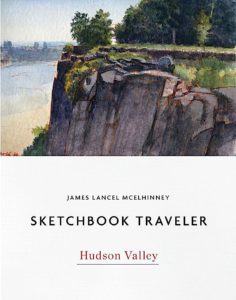The world we have known never be the same. We can beguile ourselves with the vain hope that things will return to normal, forgetting that the world has always been in flux. Human evolution has been driven by geological upheaval, climate change and plagues. Calamities like COVID-19 remind us of the fragility of life, the durability of the human spirit. For the first time in the history of the planet, a unique intelligent life-form has been focused on a single natural disaster, in real time, at the same moment in time.
Making lemonade out of bitter fruit, these quotidian posts are offered as messages of hope, not just for our own survival, but as motivation to turn our attention to the world around us, to treasure what we had previously taken for granted, to draw strength, wisdom and compassion from deeper engagements with nature.

Fort Tryon Park. Journal painting. June 7, 2015. 3.5 x 10.5 inches
George Washington was one of the luckiest men alive. At the tender age of twenty-one his actions lit a spark that would engulf European powers in global conflict for seven years. Two years later he would survive unscathed one the most crushing defeats of regular troops in British colonial history. In 1759 he married the wealthiest and most eligible widow in Virginia. Not yet thirty, Washington had come to see himself as a man of destiny.
Given command of Patriot forces in 1775, he oversaw the siege of Boston, compelling Crown forces to evacuate the city. Their response was to send an armada with twenty thousand troops to capture New York City. Losing one-fifth of his men in the Battle of Brooklyn, Washington led what remained of his army to Manhattan. Their escape was concealed by heavy fog. Pursued for the next two months, clashing with Crown forces at Harlem Heights and White Plains, Washington shifted his base across the Hudson, leaving Nathaniel Greene in command of three thousand men to fortify the rocky northern tip of Manhattan.
On November 16, 1776, eight thousand British and Hessian troops disembarked along what today is Harlem River Drive, just north of the present-day site of Peter Jay Sharp Boathouse. Wiping out a small force posted on Fort George Hill, Crown forces marched west across Kingsbridge Road, now Broadway. Scaling the vertiginous rocky heights, General Wilhelm von Knyphausen’s Hessian brigade attacked an artillery position guarding the northern perimeter of Fort Washington. When one of the gunners fell, his twenty-five-year-old wife took his place in the cannon-crew. Margaret Corbin fought on until she was disabled by a Hessian bayonet. Watching in horror, Washington must have felt that his luck had run out. Having lost half of his army in two months, he led the rest across New Jersey. One step ahead of their pursuers, the Continentals slipped into Pennsylvania to lick their wounds. Defeat would teach Washington how to make his own luck. Five weeks later what was left Washington’s army crossed the Delaware again, to deliver a bloody nose to British prestige by capturing nine hundred Hessians at Trenton.

View of the Battle of Fort Washington. November 16, 1776. Thomas Davies, Royal Artillery. New York Public Library.
Among skills British officers were expected to possess was topographical drawing, a compulsory subject at the Royal Military Academy at Woolwich. Noted as a gifted artist-naturalist, Thomas Davies (1737-1812) was employed by General Howe to record the British campaign in New York. In 1777 Davies was put in command of Fort von Knyphausen, fomerly Fort Washington. Kathie Manthorne and I live on the battlefield, just downhill from Fort Washington. The site today is preserved as Bennett Park, located at 183rd Street and Fort Washington Avenue. Davie’s prospect today is located near the intersection of Fordham Road and Sedgwick Avenue in the Bronx.
Below: Map of New York (Manhattan) Island. 1777, showing the disposition of opposing forces during the battle of November 16, 1776.

During the nineteen-thirties, newly constructed gardens, paths, stairways transformed the former battlefield into a park. Marked by a flagpole, Corbin’s fateful stand lies buried under masonry terraces, evoking an historic fortification. Day and night, the national colors fly at its summit. In the mid-nineties, celebrities like Bette Midler and Washington Heights resident Dr. Ruth Westheimer helped transform the park into one of the most beautiful in the city, and one of the least crowded. At the northern end of the park stands a cluster of reconstructed European chapels and gardens. The Cloisters was created through a unique collaboration between philanthropist John D. Rockefeller, Jr. and then curator James Rorimer, one of the famed Second World War Monuments Men. Resting my sketchbook atop a stone wall, people drifted by me as I painted. No one paused to look over my shoulder. This is New York. When film stars, world leaders or raving lunatics stroll down the avenue, nobody gives them a second look.
.
(Image and text were featured in the exhibition James McElhinney. Discover the Hudson Anew, curated by Laura Vookles. Hudson River Museum. Yonkers, New York. September 13, 2019 to February 16, 2020. Published also as a limited-edition in Hudson Highlands. North River Suite Volume One. Needlewatcher Editions. New York. 2018)
(A preview of SKETCHBOOK TRAVELER by James L. McElhinney (c) 2020. Schiffer Publishing).
Copyright James Lancel McElhinney (c) 2020 Texts and images may be reproduced (with proper citation) by permission of the author. To enquire, send a request to editions@needlewatcher.com
